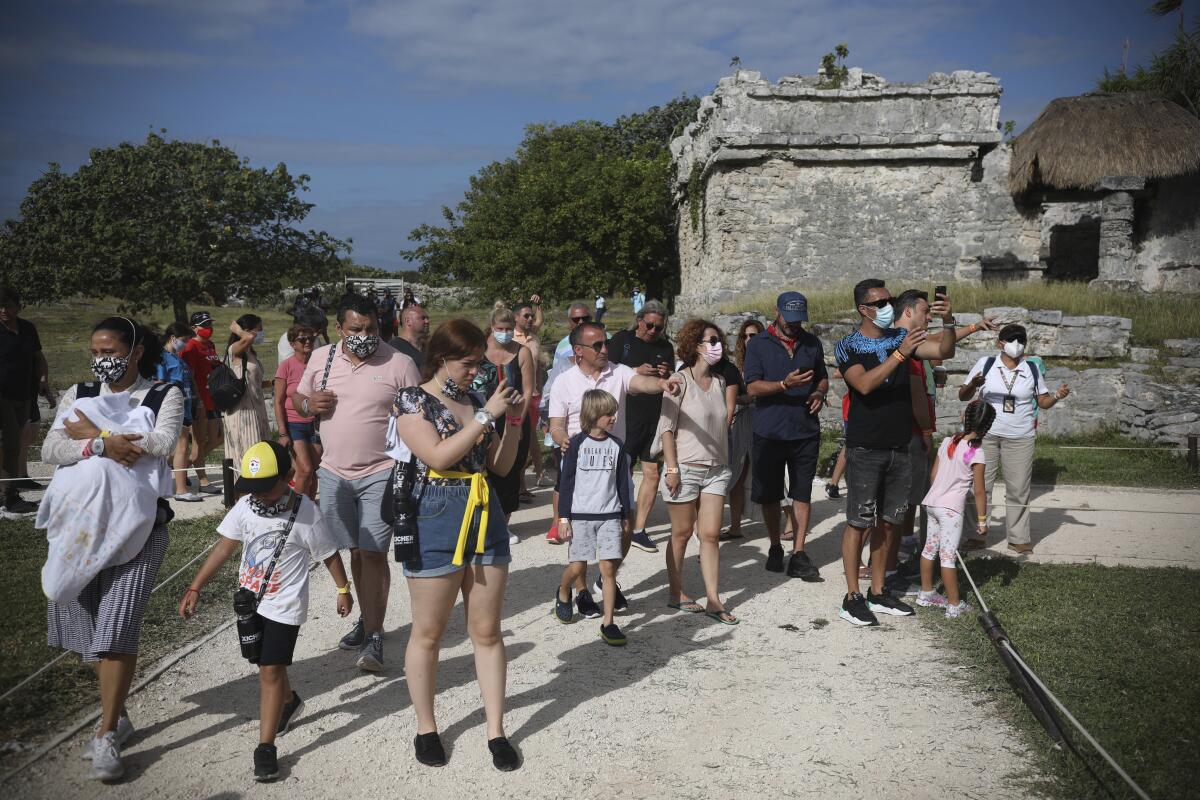Commentary: What should we do about Instagram colonialism?

- Share via
This summer, a record-breaking, estimated 220 million U.S. tourists — 85% of American adults — have been on the move. Many of them will head to Tulum, Mexico, which I also recently visited. Businesses across Tulum cater directly to U.S. tourists’ Instagram accounts. They offer decorative twinkle lights to provide flattering lighting, swings instead of seats, and neon signs — such as the bright pink cursive at a bar on the town’s main drag that declares, “I’m in Tulum, Bitches!”
Where tourism was once a way to broaden our horizons and gain a deeper understanding of other cultures, social media and the global economy have changed that. The point is no longer just to consume new experiences — it’s also to be able to show that consumption to followers back home. Now, traveling often feels like an Instagram feedback loop. Meanwhile, our search for Instagrammable views has remade whole local economies and environments, and changed the lives of thousands of people in the process.
Tulum is in southeastern Mexico’s Yucatán Peninsula, in the state of Quintana Roo. The region’s original inhabitants are the Indigenous Maya. The stunning archaeological ruins at nearby Chichén Itzá — a UNESCO World Heritage Site — are an accomplishment of their civilization. The ruins show an astronomical acumen, including an ability to predict celestial events such as eclipses, which they incorporated into their architecture to stunning effect; sophisticated agricultural techniques that allowed them to farm the seaside land; and a road network system that predated the European road network system.
I’m a third-generation Mexican American who’s been traveling back to my family’s hometown of Acaponeta, Nayarit, my whole life. I’ve been to plenty of other destinations in Mexico, too, including Tulum in 1988, when it was still a small fishing village. Then, in 1999, hoping to ride the tourism prosperity wave underway in Cancun, the government rebranded the region the Riviera Maya. Entrepreneurs, developers and immigrants from the U.S. and Europe soon followed. They set up hotels and residences, and hosted yoga festivals and dance parties. In 2004, the New York Times dubbed Tulum a “countercultural haven,” even as it pointed out the dangers of commercialization.
Since then, development — often fueled by foreign investors — has unfolded without much forethought, government oversight, or planning so fast that it has outrun the local government’s ability to provide basic services such as electricity and sewage. You won’t see the squatter camps where imported workers find themselves living on Instagram. And stunning images of divers and snorkelers in the Mesoamerican Reef System, the second largest coral reef in the world, rarely feature the human waste that’s increasingly turning up in its underground rivers.
The impacts of tourism will only get worse, with a train project connecting Tulum to Cancun on track to bring more people, plow through the jungle home of endangered habitats and destroy caves that may contain important Maya relics.
In the face of such massive changes, locals find themselves — as Matilde Córdoba Azcárate’s marvelous book about Mexico’s Yucatan peninsula puts it — “Stuck with Tourism.” Contemporary Indigenous Maya have few options but to work as construction workers, maids and taxi drivers serving the 22 million people who arrive each year at the nearby #cancunairport.
When we spent the day at a beach club, I met Rodrigo, a charming 22-year-old bartender from Tulum. He told me that the days were long, and the tips were often lousy — but he still feared the day when some new best thing would take Tulum’s place. Rosalya, my guide at Chichén Itzá, likewise told us that when she began giving tours 17 years ago — as the first woman to do so — fellow locals critiqued her for joining the tourism industry. But, she said, she didn’t see any other options.
What are the responsibilities of U.S. tourists in the face of this global inequity? Multiple articles published this summer have proposed that we stop traveling. But mitigating the negative impacts of unchecked development requires larger, structural changes, including investment in local markets and government oversight.
While I don’t want to suggest that people simply stop traveling, I do want visitors to understand our impact — especially the very material impact of our use of digital technology. Social media now drives tourism at an unprecedented pace and volume. Government tourism boards hire celebrities and influencers, from Lionel Messi to TikTok’s “Corn Kid,” to brand and promote destinations.
Travel bloggers and TikTokers make their living using algorithms and hashtags to guide travelers to remote sites of natural beauty or supposedly unknown, authentic restaurants. Businesses race to make themselves ever more attractive to visitors’ phone lenses. As visitors follow and share their experiences in real time, the images circulate faster and faster, like an accelerant to a bonfire. While governments and developers rake in foreign dollars, locals — many of whom are poor and/or Indigenous in the case of Mexico — pay the price.
But there are other ways to travel, too, including with an understanding of its impact and sustainability, with a curiosity about the history of a place and its people, and by making conscious choices about where your money is going. So instead of staying home, consider another, perhaps equally unthinkable, proposal: traveling without posting to social media. If we focus more on inquiry and less on how our trip looks to others, we can be not just consumers but participants in a cultural exchange with those whose labor makes our experience possible.
Natalia Molina is a distinguished professor and dean’s professor of American studies and ethnicity at USC. A 2020 MacArthur Grant recipient, she is the author of “A Place at the Nayarit: How a Mexican Restaurant Nourished a Community.” She is a member of Zócalo’s advisory board.
This piece was written for Zócalo Public Square.






